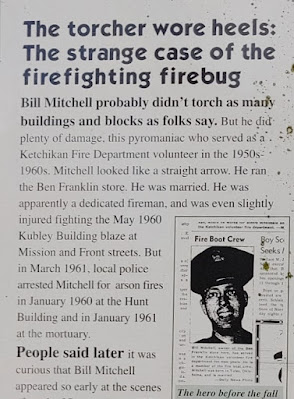 |
| There were a couple of three-sided information signs by the entrance to Creek Street. |
 |
| Here the creek gets a bit rocky so a fish ladder had been constructed to help the fish get to the upstream gravel beds where they will spawn. |
 |
| We could see the fish in the creek. |
 |
| Walking back through the park, we went through tiny Whale park. Notice the clock in the background. |
 |
| Clock in Whale park. |
 |
| Another website good for information on totem poles -https://www.akwildlife.org/news/the-history-and-significance-of-totem-poles |
 |
| A clan house had a small, short door so those entering would have to stoop. They were made this way so that any enemy entering would be at a physical disadvantage. |
 |
| Thunderbird |
 |
| These two totem stood at the entrance to the village. Their fierce expressions were to tell others passing by that they were a clan not to be trifled with. |
 |
| At Potlatch, these two totems are covered in scales/feathers painted by children from Disney cruises. |
 |
| Look out over the Tongass Narrows, part of the Inside Passage. |
 |
| Our guide talked about the significance of many of the images and totems. |
 |
| Clan house |
 |
| Thunderbird on wall in clan house |
 |
| This hole cut into the totem would be the actual entrance into a clan house. |
 |
 |
| Next photo shows back of this totem. |
 |
| Totems decay from the inside out so many of the totems have steel posts up their middle |
 |
| Alaska has over 8,700 registered aircraft, that is 3 percent of all U.S. registered aircraft. These aircraft are essential due to Alaska's size and dearth of roads. |
 |
| Ketchikan's airport is on the other side of Tongass Narrows so you have to take a ferry to get to it. |
 |
| We went through this tunnel as we headed north out of Ketchikan. You would think we would have to go through it to get back. |
 |
| There is a very tiny park by the docks with this eagle sculpture. Thundering Wings eagle was carved by world-renowned Tlingit master carver Nathan Jackson of Ketchikan. |
 |
| Ketchikan, Alaska, is known for its unique and charming stair streets, which are essentially long sets of stairs that serve as streets due to the city’s steep terrain |
 |
| Creek Street from Stedman Street |
 |
| Once back on board the ship, we watched dock and sea activities from our verandah. View of the dock as it heads southeast. Inside the breakwater was a small boat harbor. |
 |
| The Aleutian Ballad was featured in season 2 of "The Deadliest Catch" but now it is used to take tourists on crab fishing expeditions. |
 |
| Just one of the many excursions offered in Ketchikan. |
 |
| Float plane coming in for a landing. |
 |
| There were lots of buses dropping people back off at the ship. |
 |
| The Meadow Marie is a typical Alaskan salmon seiner, which is a type of fishing vessel specifically designed for salmon seining. |
 |
| Probably an excursion boat. |
 |
| Casting off the lines |
 |
| Pulling away from the dock. |
 |
| Looking up Mill Street. |
 |
| Even a hovercraft! |
 |
| Also in port was the Silver Nova, a luxury cruise ship operated by Silversea Cruises. |
 |
| The Majestic Princess that we will see again during this voyage. |
 |
| Harbor police keeping us in line. |
 |
| The 50 meter/ 164'1" motor yacht 'Jackpot' was built by Christensen in the United States at their Vancouver, WA shipyard. |
 |
| Another small boat harbor. |
 |
| Alaska State Ferry |
 |
| This smaller Alaska State Ferry was making a run across the narrows. |
 |
| Ferry in dry dock. |
 |
| You can see the boat dock at the airport. |
 |
| We saw these small breakwaters in several places. |
 |
| The servers at our table in the dining room made sure to recognize our friend's birthday even though we had eaten at a different restaurant the night of his birthday. |





























































































No comments:
Post a Comment